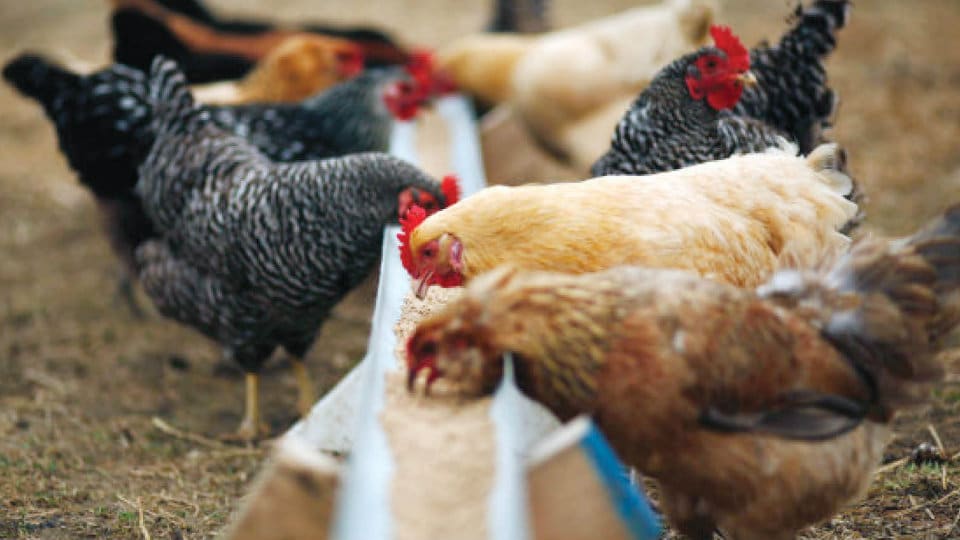In this week’s Pet Talk, Maneka tells how chickens are raised, what are the benefits of keeping them, their life span and more.
By Maneka Gandhi
I live just outside the city in a big farm. I would like to keep chickens. What are the benefits of keeping chickens?
Chickens make fun pets. They are intelligent, speak a language, have family groups, communicate. They are also very good for the rest of the farm as they eat scraps, pests, and their natural manure is good for the soil. Free range chicken eggs, I am told (since I don’t eat them), are much tastier than commercial ones.
Will keeping chickens cause any problems with my garden?
No, they don’t eat flowers or vegetables. They eat bugs and beetles and ants. They enrich the soil.
What do chickens eat and drink?
Keeping chickens is easy when they have enough to eat and drink. Full grown chickens need a constant supply of chicken feed, shell grits and water. Scraps, like leafy greens and porridge, can be additional treats. Chickens need a constant supply of fresh water, as they drink between 500 ml to 1 L of water per day — depending on weather conditions.
How long do chickens live?
Chickens, in small flocks, live several years if conditions are correct. A life span of 6-8 years is reasonable.
How are chickens raised; pastures, indoor or confined?
Chicken reared on pastures are healthier than chickens reared indoor. Confined chickens, or chickens in cages, are never healthy. However, they need housing for nesting and for when it rains or the weather is too hot.
How should I build a poultry house for my chickens?
Chicken house should have an Eastward orientation, with ventilation windows on the sides facing south and north. Make sure the ventilation exists and there is no major temperature increases.
You can use iron sheets, grass, palm leaves, to cover the roof. On the covered part of the wall you can use bricks, sand blocks, iron sheets, wood and mud.
The floor can be prepared in several ways including plastering with sand and cement or mud.
Make sure there are no cracks on the wall nor on the floor. You can have bedding materials which include wood shavings, saw dust, peanut hulls, rice husk and dry grass. Once this is removed it could be put into fertilizing gardens to boost crop yield. When removed from the poultry house, the bedding material should be heaped and covered with a polythene sheet to allow healthy bacteria to ferment all the residual feed material resulting in an increase in temperature which kills all the micro-organisms which could harm the chickens. But that is if you have not used antibiotics in the feed for the chickens or pesticides. If you have, then the material is dangerous to fields and crops.
How can I make sure that the condition inside the chicken house is pleasant for chickens?
(i) Building the house as described above on East-West orientation.
(ii) Not allowing litter material to cake, by turning it frequently with a rake or other objects.
(iii) Providing clean potable water always.
(iv) Opening and closing the curtains on the window when it is hot and cold.
(v) Avoiding overcrowding.
(vi) Providing chicken with balanced feed rations.
The most important is to give them lots of space to move naturally, fresh air and sunlight. Sustainably raised poultry eat grasses, greens, grains and insects, whereas factory farmed poultry are fed bone, feathers, blood, other animal by-products and manure, arsenic, enzymes, and antibiotics.
What material should be used for curtains in a poultry farm?
The curtaining material should allow exchange of air between the inside and outside environment. Plastic materials are not recommended. Old feed sacks make very good curtains.
How can I build a chicken house in a frequently flooded area?
There are two types of poultry houses depending on the risk of flooding. In areas prone to flooding, slated floor houses are recommended. In slated floor chicken houses, the floor is raised above the ground by at least two feet. Construct storm drains to take water directly away from the chicken house.
Is there any danger in letting them roam freely?
They are vulnerable to predators, like dogs. Unless you have a good wall, and not just a fence, you may lose them as they may wander through it. It will become increasingly difficult to find their eggs if they have fields to find secret laying spots. In conditions such as this, chickens are more likely to become egg-paranoid and broody. They will attack you if they believe you are going near their stashes.
Some owners make the distinction that their flock is either full-time or part-time free range chickens. The difference being that full-time free range chickens are left entirely to their own devices, essentially free to run wild over the property. Part-time free range chickens spend most of the day out of the coop, exploring the world however they come home at the end of the day to a safe warm coop. Vaccinate them, as they might contract diseases when they are scuttling and pecking their way across a large property.
How can I control mites in hens?
Mites are tiny little parasites that attack chickens and suck their blood. You have a mite issue if your hens begin to lose their feathers, or if you begin to see them biting under their wings or around their vents. This is how you get rid of them: i. Keep the coop clean and dry, making sure of the dark spots and corners too; ii. Pestene/diatomaceous earth/other safe insecticides should be used regularly to get rid of mites and lice; iii. Provide them with an area of dust bathing. It helps them to get rid of excess oil, moisture and mites; iv. In case your chickens live in coop full time, provide them with an artificial dust bath area out in the Sun. Use wood ash mixed with sand, dried lavender and mint in an artificial one. Clean it every day.








Dear Maneka Gandhi,
Nick, thank you for sharing this valuable information.